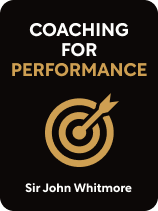

This article is an excerpt from the Shortform book guide to "Coaching for Performance" by Sir John Whitmore. Shortform has the world's best summaries and analyses of books you should be reading.
Like this article? Sign up for a free trial here.
What is performance coaching? What are the different types? How does performance consultant Sir John Whitmore explain what it means to be a performance coach?
According to Sir John Whitmore, performance coaching is a partnership in which coaches help business leaders and workers develop the skills to maximize their potential and drive performance. As a pioneer of workplace coaching, his book Coaching for Performance explains in detail the ins and outs of performance coaching.
Read on to learn more about what performance coaching is (and isn’t), according to Whitmore.
Performance Coaching, According to Whitmore
Performance consultant Sir John Whitmore is a pioneer of workplace coaching and co-creator of the popular GROW model, a coaching framework for goal-setting and performance improvement. Published in 2017, Coaching for Performance is the 5th edition of Whitmore’s groundbreaking 1992 book and offers updated information on what performance coaching is, its benefits, and methods of measuring organizational culture and performance.
In this article, we’ll explain what performance coaching is and some of the various types of performance coaching you may encounter, according to Whitmore.
One-on-One Coaching
So, what is performance coaching, according to Whitmore’s definition? Whitmore says performance coaching is a strengths-based, non-judgemental partnership in which coaches help business leaders and workers develop goals, strategies, and skills to maximize their potential and drive performance. Performance coaches should view their coachee as fully capable, resourceful, and proficient in their thoughts, abilities, and skills—the coach’s role is simply to reveal their best.
(Shortform note: Although performance coaches view coachees as equal partners, the reverse isn’t always true. Experts say that 70% of senior executives are alpha males who believe they’re smarter than everyone else and can be critical and resistant to change—making them difficult to coach.)
Whitmore says a performance coach’s job is not to instruct employees on how or what to do, which can rob your coachee of the chance to absorb information they need to develop self-confidence, autonomy, and ownership of their work.
(Shortform note: Whitmore’s rationale for allowing your coachee to learn on their own is similar to experiential learning—an approach in which instructors allow students to directly engage in a task instead of showing them how to do it. For example, a welding instructor would allow students to operate welding equipment instead of just talking about how it works so they know how heavy it is and how to physically operate it.)
Whitmore’s belief that a coach’s role is to help workers maximize their potential is rooted in psychologist Abraham Maslow’s hierarchy of needs. Maslow believed that all humans have the same basic needs and must satisfy each level of need to fulfill their greatest potential: self-actualization. His hierarchy is illustrated as a pyramid with five horizontal layers:
- At the bottom of the hierarchy are basic survival needs like food, water, and shelter.
- Once you satisfy these needs, you strive to meet mid-level needs for love, belonging, and esteem, respectively.
- Upon satisfying these needs, you aim to satisfy your final need: to self-actualize. You satisfy this need when you find purpose and fulfill your potential.
At this point, you feel capable of functioning independently, believe that others respect your ability to do so, and don’t feel the need to prove your worthiness to anyone. Whitmore says performance coaches should strive to help coachees reach this point.
(Shortform note: Psychologists say you can follow four science-based steps to achieve self-actualization: First, be open to new ideas and perspectives so you can learn and grow. Second, know your values so you can set goals that mean something to you and that you’ll feel good about when you achieve them. Third, ensure that your end goal is self-actualization—not love or esteem (the latter two are critical but not the end of the road in your development). Finally, be true to yourself. Pursue things that matter to you and you’ll enjoy your self-actualization journey.)
Three Other Types of Coaching
When Whitmore explains what performance coaching is, he mainly focuses on 1:1 coaching; however, he also touches on three additional types of performance coaching in Coaching for Performance.
1. Coaching for Team Performance. Coaches work with leaders to foster a culture of openness, curiosity, and trust to maximize performance. To do this, help leaders:
- See that each team is its own entity with unique potential that the leader can help reveal
- Develop teams’ self-awareness, ownership of outcomes, and collaborative skills
(Shortform note: Experts warn that some teams resist coaching. Members may challenge coaches directly or not participate in meetings. If this happens to you, don’t default to unhealthy coping responses like being defensive or gossiping with team members who are participating about those who aren’t. Instead, make honest observations like, “This meeting feels tense. I’m sure I’m not the only one who feels it. Can we talk about your thoughts on our work together?)
2. Coaching for Lean Performance: Coaches work with leaders to engage employees in a process of continuous learning, growth, and improvement; they streamline operations, reduce waste, and create value for customers. To do this, work with the leader to:
- Identify a big picture, organizationally
- Implement changes to reach the goal
- Have ongoing conversations about what’s working, and what’s not, to assess progress
- Standardize effective processes
(Shortform note: Some experts say that lean coaching is ineffective. They argue that 70% of lean coaching transformations fail and that within five years of starting them, 90% of organizations are in the same position or worse. The reason? Coaches’ failure to provide a level of coaching that enables leaders to see the value of a lean system. As a result, leaders don’t buy into the concept and thus don’t pursue change wholeheartedly.)
3. Coaching for Safety Performance: Coaches work with leaders and workers to improve workplace safety. To do this, build workers’ awareness of unsafe behaviors and encourage ownership of outcomes.
For example, if an employee engages in an unsafe practice, immediately stop them and ask them, without judgment, to identify the unsafe practice. This raises their awareness. To deepen their awareness, ask about their understanding of the risks associated with the unsafe behavior. Finally, encourage them to take ownership by committing to take a different action in the future.
(Shortform note: Experts recommend some strategies to boost your coaching for safety efforts that Whitmore doesn’t mention. First, be aware of how well your coachee understands safety protocols so you can effectively track and support their progress. Second, encourage peer-to-peer safety coaching between managers and workers. This allows the latter to see the former less as punitive adversaries than partners sharing information.)

———End of Preview———
Like what you just read? Read the rest of the world's best book summary and analysis of Sir John Whitmore's "Coaching for Performance" at Shortform.
Here's what you'll find in our full Coaching for Performance summary:
- A guide on the ins and outs of performance coaching
- Strategies to maximize employees’ potential and performance
- How to measure organizational culture and the impact of your work






